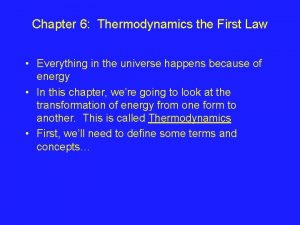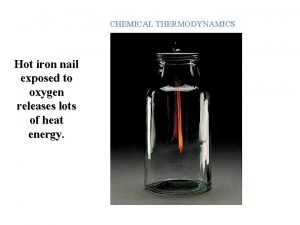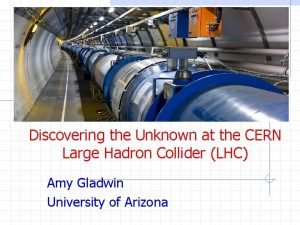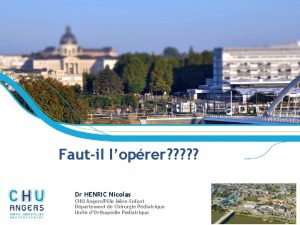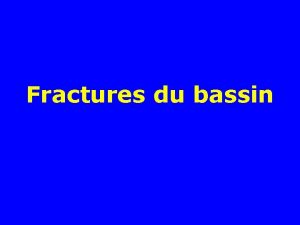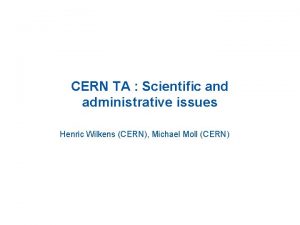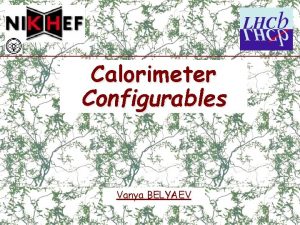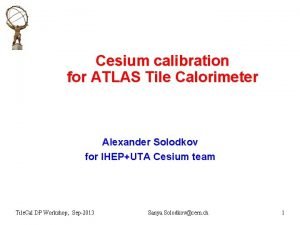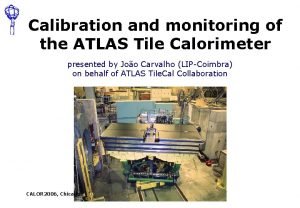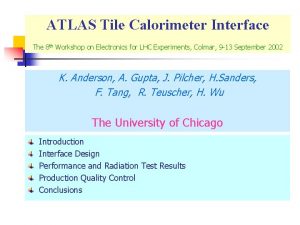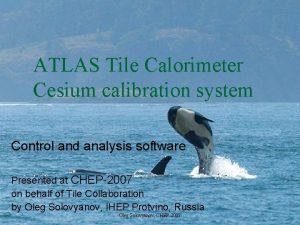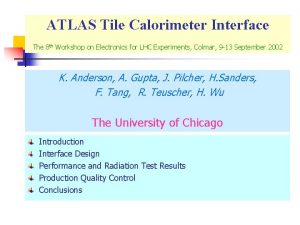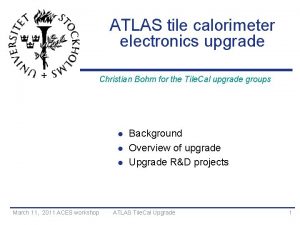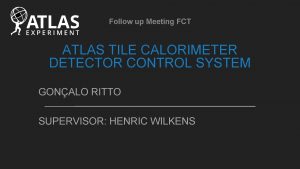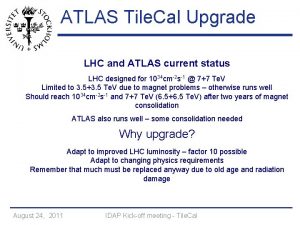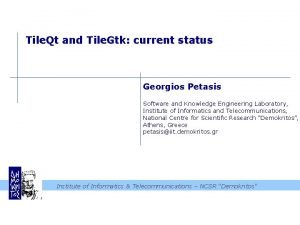ATLAS Tile Calorimeter Performance Henric Wilkens CERN on














- Slides: 14

ATLAS Tile Calorimeter Performance Henric Wilkens (CERN), on behalf of the ATLAS collaboration.

The Tile Calorimeter • • • Steel absorber plates and plastic scintillator tiles Coverage: Long Barrel |η| < 1. 0, Extended Barrel 0. 8 < |η| < 1. 7 Four partitions, over 4, 900 cells, two PMTs per cell, two gains per PMT Three longitudinal layers: A, BC, & D total thickness of about 7λ Design resolution for jets(LAr + Tile): 22/04/13 Henric Wilkens (CERN) 2

Energy Calibration Epmt = Amplitude × CADC→p. C × ξlaser × ξCs × Cp. C→Me. V Factors in the calibration: • CADC→p. C : The Charge Injection System monitors electronics stability. Calibrated 3 times/week. • ξlaser: A laser system monitors PMT gain and timing of individual channels. Calibrated 3 times/week + Empty bunch crossings (1 Hz) • ξCs: Maintain same cell response to known source. Calibrated monthly. • Cp. C→Me. V: 11 % of the Tilecal modules where calibrated at the SPS with e+-, m+-, hadrons, to determine the Electromagnetic Scale. Calibration strategy: Use the laser to tune channels that drift more than a few % in between monthly Cs runs to maintain the determined E-scale 22/04/13 Henric Wilkens (CERN) 3

Cesium calibration Each Tilecal cylinder is equipped with a system of pipes, transporting a Cs 137 source through each of the tiles. ( ~17 km of pipes in total). Illuminates tiles with 662 ke. V photons (source ~10 MBq), readout through the integrator system. Runs last long, not compatible with collisions, ie are taken during MD/TS (~1 month). 22/04/13 Henric Wilkens (CERN) 4

Stability of the Cesium Response Cs calibration has a precision of 0. 3%. Corrects for deviations from the expected Cs decay response: • 2009 -2010: up-drift of about 0. 8% per year. • since 2011: down-drift when beam is on, up-drift when beam is off & during low luminosity heavy ion run. • largest down-drift in innermost part of the tile calorimeter (sample A), is < − 3. 5%. 22/04/13 Henric Wilkens (CERN) 5

Laser system • Laser system has a precision of < 1%. • Gain variation observed by the laser system is compatible with the variation seen by the Cs system. • Excellent agreement between laser and Cs calibrations 22/04/13 Henric Wilkens (CERN) 6

Charge Injection System • Only ∼ 0. 04% shift in calibration constants of fully functional channels (∼ 99%) over the entirety of 2012 • Tile-wide calibration constants for all channels in both gains are very stable • Typical channel calibrations deviated little from the average 22/04/13 Henric Wilkens (CERN) 7

Calibration of the Gap & Crack Scintillators • • • Gap scintillators (E 1, E 2): − 3%, mostly PMT gain variation (laser ∼ Cs response) Crack scintillators (E 3, E 4): ∼ − 15% 1/3 scintillator irradiation, 2/3 PMT gain drift. Re-calibrate with laser/Cs info (no Cs in E 3/E 4), checked with muons Z → ee analysis (by e/γ group) showed a stable response. Partial recovery seen when beam is off, f. i during machine developments and technical stops. 22/04/13 Henric Wilkens (CERN) 8

Signal reconstruction • The signal from a PMT is made up of seven ADC samples spaced 25 ns apart. • An optimal filtering algorithm is used to determine the amplitude, timing, and pedestal of the signal 22/04/13 Henric Wilkens (CERN) 9

Energy Performance • • • Large phases bias the reconstructed energy Apply phase corrections on pulses with E > 160 Me. V Energy difference vs online time before (red points) and after phase correction (blue points) • Difference between energy calculated online with the Digital Signal Processor (DSP) and offline • Max expected difference scales with the overall calibration of each channel 22/04/13 Henric Wilkens (CERN) 10

Timing performance • Cell time corrected for its mean time. • Muons deposit only a small fraction of their energy: – ~2 Ge. V: 1. 15 ns < σTime <1. 3 ns. – ~20 Ge. V: σTime ∼ 0. 6 ns • Selected cells Ecell > 20 Ge. V belonging to reconstructed jets. • Excluded tile cells with unstable timing (1% of cells) 22/04/13 Henric Wilkens (CERN) 11

2012 Tile Efficiency Summary Tile Data Quality efficiency for 2012 was 99. 6%. Data is rejected when ≥ 4 consecutive modules are not recording. Better stability of the electronics in 2012. 22/04/13 Henric Wilkens (CERN) 12

Energy scale validation The electromagnetic energy scale is studied with muons: cosmics, scraping beams, and collisions. Shown in the table is d. E/dx [Me. V/mm] for data and monte carlo for the cosmic muon analysis. Study with muons from W decays in pp collisions is ongoing. The current uncertainty on the energy scale is 3%. 22/04/13 Henric Wilkens (CERN) 13

Conclusions • The calibration systems were improved and continued to perform well: – Cs and laser calibrations have excellent agreement allowing inter. CS calibrations with laser. – CIS calibration saw only ∼ 0. 04% shift over 2012. • Time in each cell is reconstructed with an average time of 0. 30 ns with a RMS of 0. 85 ns. • The Tile Calorimeter performed very well over the last three years: – 99. 6% data quality efficiency in 2012. – DAQ/DQ inefficiency considerably reduced in the second half of 2012. • The performance of Tilecal is studied with muons, allowing us to quote a 3% uncertainty. We work on improving this number. 22/04/13 Henric Wilkens (CERN) 14
